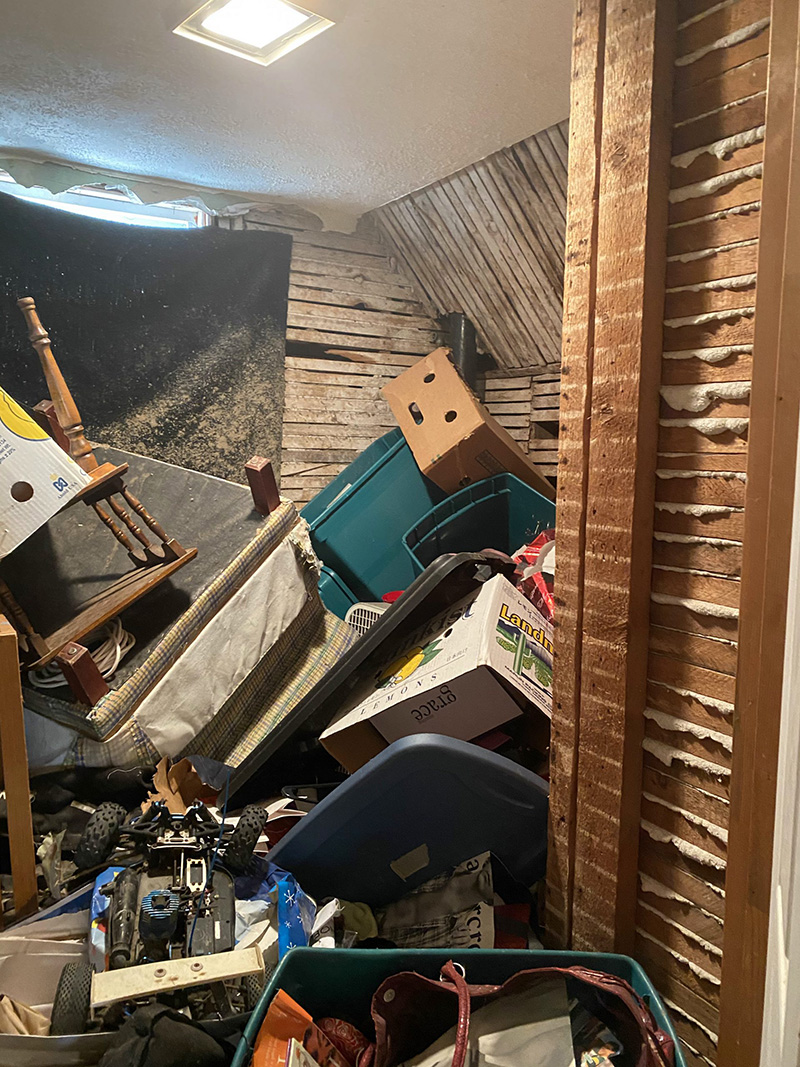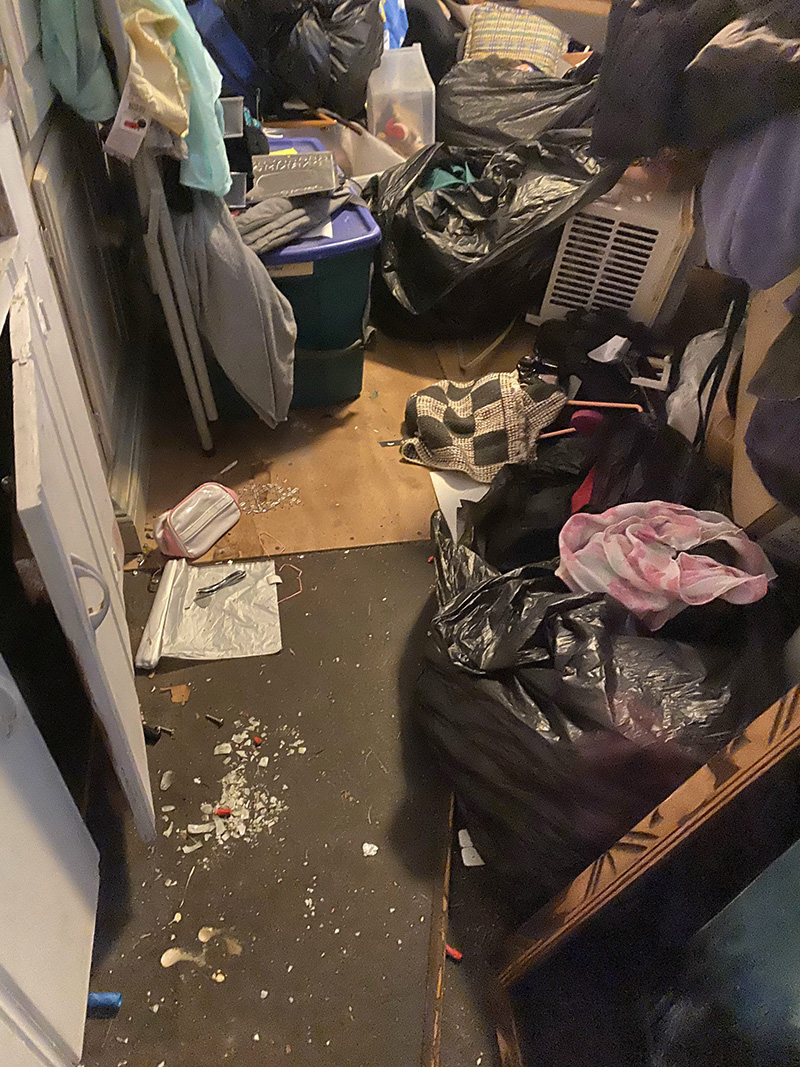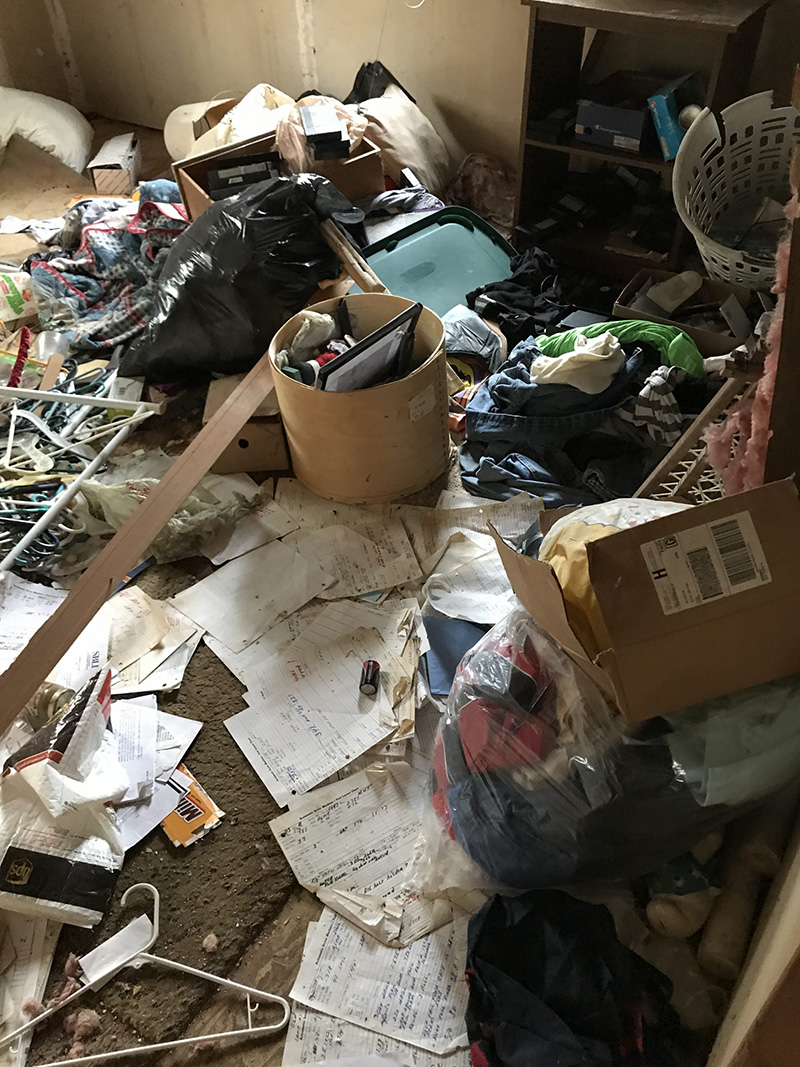Help! My Renter is Hoarding, What Do I Do Now?
| . Posted in News - 6 Comments
By Kimberly Rau, MassLandlords, Inc.
Thanks to television, you’d be hard pressed to find anyone not familiar with the concept of hoarding. Images of boxes piled to the ceiling, overflowing toilets, toxic refrigerators and cats climbing on every surface are plentiful. But while such programs make for engaging entertainment (if only to make us potentially feel better about our own messiness or mild clutter) compulsive hoarding is a disease. It’s also something that no landlord wants to have to deal with. Recognizing the signs of hoarding before the problem becomes overwhelming can be difficult, and, once a hoarding situation is in effect, it can be hard to correct.

Hoarding can cause structural problems and pest infestations, and can also create a really difficult clean-up job once a tenant leaves.
Image Credit: CC by SA_4 MassLandlords
In this article, we’ll look at what hoarding is, how to recognize the signs of a potential hoarding problem in your rental units, and what recourse you have as a landlord.
What is Hoarding?
Hoarding disorder is defined as “a persistent difficulty discarding or parting with possessions because of a perceived need to save them.” Such disorders can be mild or severe, but what’s important to take note of here is the word “disorder.” Compulsive hoarding, or hoarding disorder, is classified as a mental illness. In 2013, the American Psychiatric Association officially recognized hoarding disorder as a disability. When that happened, it fell under the protections of the Fair Housing Act, which means that landlords cannot immediately evict when the warning signs of hoarding become obvious. We’ll touch more on the ramifications of that later.
The biggest thing to remember is that hoarding disorder is a protected disability. You cannot evict someone because they are a hoarder (though you do have the right as a landlord to ensure your rental unit is safe). Hoarding disorder is also a more severe problem than a tenant simply having a messy living room or a sink full of dishes (as annoyed as that may make you during an inspection). When it comes to animals, a hoarding situation is more extreme than the kitten your tenant “forgot” to mention they took in (though again, if you have a no-pets rule, you may still want to address that).
There are Multiple Degrees of Hoarding
Not all hoarding disorders are created equal. While we’ve established that hoarding disorder is a more serious problem than general untidiness, it’s important to remember that “cats and boxes piled to the rafters” is an extreme example of hoarding disorder. In fact, there are five degrees of hoarding, and the lowest levels of the disorder may not look that different from a cluttered house.
The first degree isn’t what most people would recognize as stereotypical hoarding. People with level-one hoarding disorders typically have homes with small amounts of clutter. Their doorways and stairs will be accessible, and there are minimal areas with animal waste in the house. If you visit, you won’t notice a bad smell. Still, the devil is in the details.
“The lack of clutter might hide the condition, but the individual may still have difficulty throwing away items,” noted an article by The Recovery Village. Level-one hoarders may also shop for unnecessary items compulsively.
Level-two hoarders will have homes where clutter is present in two or more rooms. Visitors may notice light odors, as well as overflowing trash cans, light mildew in kitchens or bathrooms, one exit blocked by clutter or objects, pet dander or waste puddles, and “limited evidence of housekeeping.”
Recovery Village also notes that people at this level may be reluctant to have people in their home, or may be embarrassed by the state of their house, leading to anxiety or depressive states.
Level-three hoarding is classified by a house with an unusable bedroom or bathroom, strong smells throughout the home, visible clutter outdoors, many pets, and “heavily soiled” food preparation areas. You may also notice evidence of rodents or insects, neglected animal care, and light structural damage.
Hoarding levels four and five are the ones popularized by reality television shows such as Hoarders. At this point, homes will have structural damage, noticeable mold and mildew, insects and rodents, inaccessible points of egress, unusable bathrooms and kitchens, and, at the worst stages, fecal matter throughout the residence. There also may be more animals than should be allowed. At level 5, the home may no longer have electricity and running water.
People with homes at these hoarding levels also often have very poor hygiene and increasingly poor mental health.

Why is Hoarding a Problem for Rental Properties?
From the descriptions above, it’s clear why higher levels of hoarding may spell real trouble for a landlord. This problem is only compounded if the affected rental unit is part of a multi-unit property.
Pest control
One area where hoarding can cause a big problem for rental housing units concerns vermin such as insects or rodents. If a tenant has a problem with hoarding paper, such as mail, catalogs or magazines, the pile up will appeal to mice or rats, who use paper to make nests.
Unfortunately, it doesn’t stop with mice or rats, either. These furry rodents can bring bedbugs, fleas and other insects in with them, who are also looking for a dry place to propagate. If you’re especially unlucky, the vermin that have come in to nest in the piles of paper will bring termites with them, which can lead to severe structural damage.
That’s bad news for a single rental unit, but it can be even more catastrophic for a multi-unit building. Bedbugs are a nightmare to get rid of, and they don’t recognize the boundaries of apartment walls.
If your tenant hoards food or garbage, you may also have to contend with ants, flies and cockroaches, all of which can become problems for the neighbors as well. We’ll discuss what you can do about those issues later on as well.
Indoor air quality
While improving outdoor pollution levels has been on the government’s radar for decades at this point, the focus on indoor air quality is relatively new by comparison. Better late than never, though. At this point, indoor air may have more pollutants than outside air, and that’s in homes that do not have hoarding issues to contend with.
With hoarding, the problems with indoor air quality multiply. If your tenant hoards food or lets trash pile up, or has a nonfunctional fridge or toilet, the decaying waste products can release dust, harmful odors and ammonia. Old food can also be a great breeding ground for mold and fungus, which can pose serious health risks for even the healthiest individual. If plumbing problems crop up because of nonfunctional toilets or sinks, mildew and mold may well follow. These are problems that will affect anyone living in the rental unit and, if left unchecked, neighboring tenants as well.
Plumbing and sanitation problems
Even if your tenant tries to keep the bathroom functional, if there are things piled up on every surface, something may clog the toilet. Or, the plumbing may break and your tenant is worried about telling you because they don’t want you to see how they’ve been living. A backed up toilet or tub can lead to more air quality issues, but also can destroy floors and walls (and the ceiling of the tenants below).
If your tenant is hoarding animals, the sanitary problems from that can be many. Old pet food attracts pests and mold. Uncleaned litter boxes lead to air quality problems, and will encourage pets to start relieving themselves in other areas, leading to structural damage, more air issues, and possibly more bugs. In extreme situations, an animal dying unnoticed in the apartment is going to cause unpleasant odors for anyone in the vicinity.
Fire hazards
A hoarder’s house can be such a fire hazard that the National Fire Protection Association (NFPA) has published an entire page on it, along with a safety tip sheet for reducing fire risks and a guide on how to talk to someone with hoarding disorder.
In short, occupants living in a house where hoarding has taken over are at greater risk of dying in a fire. The house itself becomes a fire hazard, with things piled up and electrical outlets blocked by flammable materials. Rodents chew wires, which can cause fires. If a fire does occur, it may be impossible to leave the house due to blocked exits. When firefighters respond, they run the risk of being injured by the debris in the home, and may have trouble finding and rescuing the home’s occupants. In Medford last fall, rescue workers responded to a cardiac arrest call. The home turned out to be a hoarder’s residence, and it took a half an hour for personnel to clear a path from the second floor to an exit so they could transport the woman to the hospital. Fighting a fire in a house full of garbage is also more difficult, according to the NFPA.
If your tenant lives in a unit that is adjacent to others, the fire may spread throughout the building. Even if contained, smoke may damage neighboring homes and may affect air quality.
A responsibility for safety
While it is illegal to evict someone because of their disability, you as a landlord still have a responsibility to keep your rental units safe and habitable under the state sanitary code. If you have a multi-unit rental situation, you also owe it to your other tenants to ensure that their well-being and safety are not compromised. Hoarding, therefore, requires careful work to get under control, and, if your tenant cannot maintain a safe environment, you may be able to evict them for other code violations.
That’s not meant to disparage anyone suffering from mental illness. Everyone deserves shelter. But if the home becomes a fire hazard, for instance, and your tenant is not able to take steps towards fixing the issue, you still have recourse. We’ll get to that shortly.
I Suspect My Tenant is Hoarding. How can You Tell when Someone is a Hoarder?
So, if hoarding is more complicated than a closet that can’t properly close due to the clutter, but low levels of hoarding disorder don’t look much worse than a stereotypically messy home, how is a landlord supposed to identify a problem before it gets out of hand?
One problem with hoarding disorder is that the more severe the problem is, the less likely your tenant will be to readily allow you, or maintenance workers, into their home. However, as a landlord, you do have a right to inspect your property (with the legally required notice, of course). If there’s a problem, a tenant with hoarding disorder won’t be able to “hide the evidence” in 24 hours. This is also why we at MassLandlords advise that landlords perform a walkthrough of each rental unit at least once per year. It’s so important that we’ve made it part of our level-one landlord certification annual maintenance checklist.
Since hoarding can also lead to structural or vermin issues, keep an eye out for these problems as well (especially in multi-unit buildings). Though a tenant who is a hoarder may not alert you to issues, their neighbors may. Are people in the adjoining units complaining about roaches, mice, or other pests? Have they reported a leak? Smelling a bad odor? If you start to hear about issues that come from one unit in particular, it may be time to schedule an inspection.
Things get trickier with single unit properties, but inspections (or appointments for maintenance and improvements) can give you a heads up before problems get out of hand. If you go in and see that the home is particularly messy, you are within your rights to request your tenants clean up. One clear sign of hoarding is the inability to use bathrooms or kitchens for their intended purposes.
Landlord Edward A. experienced issues with a tenant who hoarded. The tenant’s possessions seemed minimal at first, and then a large moving truck arrived, full of “boxes and bags” that filled up the first floor of the home.
“Even my porch was full,” he noted. “She barely had a walkway cleared in her bedroom from the door to her bed. It was a fire hazard to say the least.”
Calling in the experts
If you see a fire, you call the fire department. If someone falls in a parking lot and hurts themselves, you call an ambulance. If you witness a robbery, you call the police. But who can you call for help with hoarding?
It’s not illegal to be a hoarder (though some of the results of hoarding may be against the law). Therefore, calling the police is not likely to do much unless there is an actionable offense to report. If you suspect that your tenant’s hoarding has put their home in violation of fire codes, the fire department may be able to conduct an inspection. You can call animal control if you suspect your tenant is hoarding animals. But these are situational solutions. What can you do about hoarding in general?
As awareness of hoarding increases, many municipalities have risen to the challenge and started groups that can help connect hoarders with resources. For instance, in 2023 MassHousing updated its hoarding resource directory, which includes mental health groups, organizing and clean-out services.

What Are Reasonable Accommodations for a Tenant with Hoarding Disorder?
Since hoarding disorder is a protected disability, you cannot simply evict someone for being a hoarder. Your tenant may request accommodations for their disability, however, this does not mean you must allow the hoarding situation to continue. You can agree to a clean-up plan, for example. Usually, lawyers advise that you not bring up accommodations with someone with a disability, suggesting instead you wait for them to address the issue with you.
But, hoarding is different.
“Hoarders tend to be secretive so they rarely will request an accommodation,” states A.J. Johnson of A.J. Johnson Consulting Services. “It is often up to management to start the process.” Since hoarders may not be aware that they have a problem, this also may put the onus on you, or your property manager, to start the discussion. Johnson further advises that, if you are in doubt as to whether you are witnessing a hoarding situation or simply poor housekeeping, that you consult a social service or fair housing department. In Massachusetts, you might try the tenancy preservation program (TPP).
The tenancy preservation program exists to help tenants who are facing eviction for many reasons, however, we were unable to reach anyone to discuss hoarding specifically before press time. Generally TPP is only accessible to a renter after you as the landlord have filed a for cause eviction (e.g., chronic blockage of fire egress).
A reasonable accommodation for someone with hoarding disorder does not mean that health and safety standards should be disregarded. Such standards must still be met even in the face of a disability.
A typical accommodation, then, for hoarders might be an extension of time to get help for their illness and start the cleaning out process. A schedule of inspections can be made as well. Documenting all issues is important, as is having a clear plan of action for fixing the specific cause violations. Set goals and timelines and stick to them. Be patient with your tenant and don’t judge, but be firm about keeping everyone safe and healthy.
When Is it Okay to Evict a Tenant with Hoarding Disorder?
Sometimes, reasonable accommodations don’t work. Hoarding is a mental disorder and, like many mental illnesses, can take a long time to get control of. Sometimes people never recover.
It is never okay to evict someone because of their mental illness. Doing so can set you up for discrimination lawsuits. It’s also unfair to the person struggling with hoarding disorder. This means you cannot list “being a hoarder” as the cause for your eviction.
That said, when you find yourself in a situation where health and safety are at risk, it may be time to terminate the tenancy. Instead of starting the eviction process for an illegal reason (e.g., hoarding), you need to cite the specific lease violations. If your tenant truly suffers from hoarding disorder to the point where you are concerned for the wellbeing of your tenant, property, or adjacent neighbors, this should not be hard to do.
Multiple animals may violate the lease, either because the lease allows for no animals at all, or a limited number. (Even emotional support animals should have written permission to be in the rental unit.) If exits are blocked, this poses a fire hazard, which is a safety issue. If your tenant is hoarding dangerous items (such as explosives), you may have recourse there. If your tenant is damaging the property, that may be another avenue to explore.
If none of those seem to apply, the MassLandlords rental agreement has a clause requiring the renter to keep the premises in a clean and sanitary condition. An advanced hoarding disability will violate this clause.
Remember: a termination notice for hoarding will not list the disability (i.e., hoarding), because that would be unlawfully discriminatory. (Also, you are unlikely to be qualified to render such a diagnosis.) A termination notice will list the specific violation of the rental agreement (e.g., inability to access and use sanitary facilities).
“We had the town building inspector inspect the building,” said one landlord, who went only by L. in their communications with us for this story. “He told the tenants it was a fire trap and they had to clean it. [We] ended up in court and had to evict the tenant...as they had stopped paying their rent.”
Once in court, you will hope TPP can help your renter, correct the lease violations, and get your case dismissed. The goal with a hoarding eviction is to correct the negative impact of a hoarding disability, not to remove the renter living with that disability.
How to help a tenant with hoarding disorder before court
To someone who is not a hoarder, the answer about what to do with a house full of garbage, animals or other items may seem obvious: Get a dumpster and clean it up. Call animal control and rehome the pets. List the compulsive purchases on eBay and use the money to pay the rent.
Don’t do any of that. Your attempts to “help” in that way could make the problem worse.
The International OCD Foundation has an extensive publication about how to help someone with hoarding disorder. In it, they state that simply going in and clearing out the clutter will only serve to anger the person with hoarding disorder and may cause severe emotional distress. And, clean outs are not long-term solutions. The clutter may disappear, but that doesn’t cure the disorder that caused it in the first place. Without help from medical professionals (including therapists who specialize in hoarding disorders), it will only be a matter of time before you’re back at square one.
Instead, The Recovery Village suggests, when dealing with someone with hoarding disorder, communication and patience is key. Focus on small victories and the positive, and keep your expectations reasonable (in the case of landlords, this means not expecting a pristine rental unit in a week). You can also suggest your tenant seek help from a professional. Since Covid, many doctors and therapists are offering telehealth appointments, which may be welcome if your tenant does not like to leave the house.
Remember that renters who have not sought help on their own can be discovered and brought into the safety net once in court.
Conclusion
Hoarding is a serious mental illness and should not be taken lightly. If you discover your tenant is a hoarder, be patient, but also be careful to take care of your rental property and your other tenants. If you start to realize that the reasonable accommodations you have decided on are not working, your best bet may be to find legal ways to terminate the tenancy.
The landlords we were able to speak with during this article process had two things in common when talking about their experiences with tenants who hoarded: their compassion, as well as their frustration, for the situation at hand. Though they attempted to work with their tenants, in the cases we heard about, no one had successfully alleviated the problem and retained the tenancy. Edward had compassion for his renter’s struggle and clear emotional attachment to her possessions, many of which turned into trash as they sat on the porch exposed to the elements. He stated it took several years before he felt forced to evict his otherwise “sweet, intelligent and respectful” tenant.
And once the tenants had left, the aftermath was still an uphill battle for the landlords.
“[We] filled two construction dumpsters of trash they left behind,” L. noted in their communications with us, “a lot of trash for just two people in a two-bedroom apartment.”





I have a 2 bedroom property I rent out to a 33 year old man who has mental illness but is hoarding lots of wood ,tyres anything in the shared alley owned by the council,also using the front garden with non waste materials.Complaints by neighbours and now Enviremental health have told me I can go to court if this is not cleared.he has been told to remove and clean up and also by my agency.as I am the landlord what can I do next as he takes no notice and materials are getting worse .
Is there anywhere I can get advice
Stephanie, feel free to email us at hello@masslandlords.net for help options.
Very Interesting!!!
thanks for info
How can landlords balance empathy and enforcement when dealing with a tenant exhibiting hoarding behaviors, and what community resources can be tapped into for assistance?
I have a neighbor who has extreme hoarding and now the neighborhood is being infested with rats. The owner has made the house a section 8 house and it’s not interested in it being destroyed and the neighborhood is infested now with rats, eating holes in their house and wires and hoses, what can I do to get this legally rectified